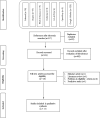Effects of temperature and humidity on the spread of COVID-19: A systematic review
- PMID: 32946453
- PMCID: PMC7500589
- DOI: 10.1371/journal.pone.0238339
Effects of temperature and humidity on the spread of COVID-19: A systematic review
Abstract
Background: Faced with the global pandemic of COVID-19, declared by World Health Organization (WHO) on March 11th 2020, and the need to better understand the seasonal behavior of the virus, our team conducted this systematic review to describe current knowledge about the emergence and replicability of the virus and its connection with different weather factors such as temperature and relative humidity.
Methods: The review was registered with the PROSPERO database. The electronic databases PubMed, Scopus, Web of Science, Cochrane Library, LILACS, OpenGrey and Google Scholar were examined with the searches restricted to the years 2019 and 2020. Risk of bias assessment was performed using the Joanna Briggs Institute (JBI) Critical Appraisal Checklist tool. The GRADE tool was used to assess the certainty of the evidence.
Results: The initial screening identified 517 articles. After examination of the full texts, seventeen studies met the review's eligibility criteria. Great homogeneity was observed in the findings regarding the effect of temperature and humidity on the seasonal viability and transmissibility of COVID-19. Cold and dry conditions were potentiating factors on the spread of the virus. After quality assessment, two studies had a high risk of bias, eleven studies were scored as moderate risk of bias, and four studies were classified as low risk of bias. The certainty of evidence was graded as low for both outcomes evaluated.
Conclusion: Considering the existing scientific evidence, warm and wet climates seem to reduce the spread of COVID-19. However, these variables alone could not explain most of the variability in disease transmission. Therefore, the countries most affected by the disease should focus on health policies, even with climates less favorable to the virus. Although the certainty of the evidence generated was classified as low, there was homogeneity between the results reported by the included studies.
Conflict of interest statement
The authors have declared that no competing interests exist.
Figures
References
-
- Mourtzoukou EG, Falagas ME. Exposure to cold and respiratory tract infections. Int J Tuberc Lung Dis. 2007;11: 938–43. - PubMed
-
- Human Coronavirus. In Types Centers for Disease Control and Prevention. 2020 [cited 2020 March 24]. Available from: https://www.cdc.gov/coronavirus/types.html
-
- International Committee on Taxonomy of Viruses. 2020. Available from: https://talk.ictvonline.org/?Redirected=true.
Publication types
MeSH terms
LinkOut - more resources
Full Text Sources
Miscellaneous


